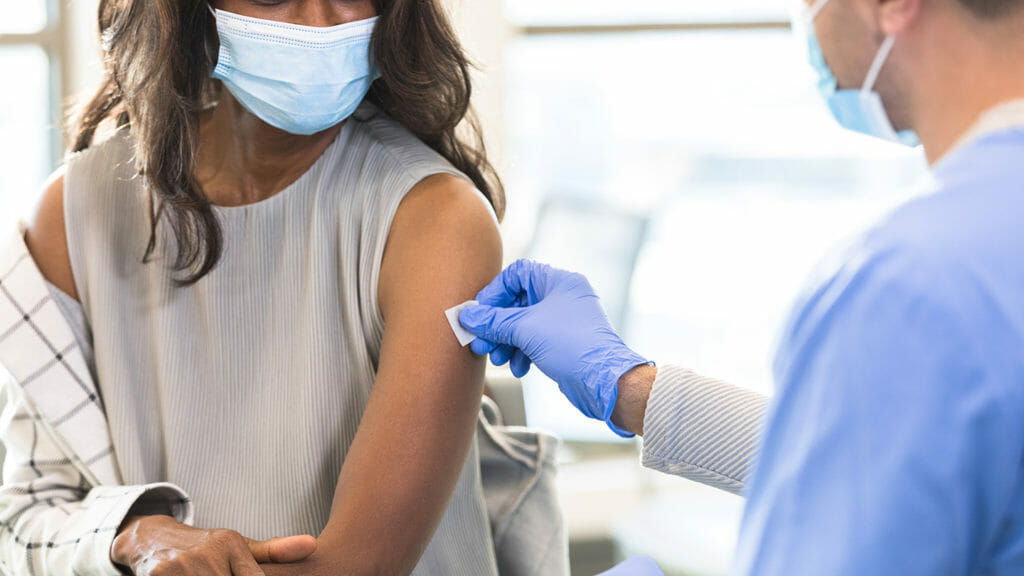
Vaccine uptake by senior living residents is being hampered by barriers to access, vaccine fatigue and misinformation, according to two providers.
During a LeadingAge policy update call on Monday, industry representatives discussed issues related to vaccine access, operations, reimbursement and trust.
The nation is entering an “unprecedented vaccine season” with the availability of vaccines for the three viruses most responsible for hospitalizations among older adults: influenza, COVID-19 and respiratory syncytial virus, or RSV. With the privatization of the COVID-19 vaccine, however, arranging vaccination clinics is becoming more difficult for senior living providers.
Carol Williams, an infection preventionist with continuing care retirement / life plan community operator Rockwood Retirement Communities, based in Washington state, recounted her struggle to schedule an on-site COVID-19 vaccination clinic after the Food and Drug Administration and the Centers for Disease Control and Prevention approved the updated vaccines in mid-September.
Williams said she contacted private companies, area pharmacies, the local health department and the community’s long-term care pharmacy, only to run into a “stalemate” due to vaccines being on backorder, the need to update policies, and concerns about reimbursement.
“There were a lot of barriers in the beginning,” she said. “No one could give me a date, and every person reminded me it was private now and not for free any more.”
Rockwood is offering its first vaccine clinic this week after working with a private company, but Williams said that struggles with reimbursement limited the number of vaccines the company was willing to provide at its first clinic. Approximately 30 independent living residents are still waiting for an upcoming clinic, she said.
“I’m disheartened that with all of the resources that we have, that the people who are most at risk for getting very ill at the time hospitalizations and death rates were going up from COVID, who wanted a vaccine, were unable to have access to that,” Williams said. “Staff that wanted a vaccine were able to go to a local pharmacy and get one at the end of September, but most at-risk residents were not able to get one until this week.”
Access barriers aside, Williams said that another challenge she faced was vaccine hesitancy, mostly from staff members.
Although residents have trust and confidence in the vaccines, she said, Williams said that she is seeing vaccine fatigue with the introduction of updated COVID-19 shots and this year’s new RSV vaccine. She added that she also has encountered confusion about the RSV vaccine for older adults.
“There is a little bit of a gap in knowledge going out, not only to the general public, but also healthcare providers,” Williams said. “I had to do a lot of education about what these vaccines are, who recommended it, who they’re recommended for and where to find answers to questions.”
Workarounds for new problems
Nina Tan, a regional supervisor for California-based nonprofit senior living provider HumanGood, said she ran into similar roadblocks initially, being told by one pharmacy that it was going to cost an affordable housing community $600 to host an on-site clinic.
“That never happened before,” Tan said. So she turned to another local vaccine provider, only to find that it only had the flu shot available in September. And a local health plan created further challenges by no longer offering on-site community vaccine clinics, necessitating transportation for residents with mobility issues to that provider’s vaccination sites.
Tan said she decided to wait until the flu shot, COVID-19 vaccine and shingles vaccine all were available, adding that the first vaccine clinics for the communities she oversees are scheduled for next week.
Tan said that whenever she schedules a vaccine clinic, she and her team initiate the resident paperwork and deliver it to the vaccine provider ahead of time to gain insurance approvals. The extra time on the front end creates a smooth process during the clinics, not only for the nurses administering the vaccines but also for the residents, she said.
Prioritizing long-term care
Wiliams said she’d like to see long-term care residents prioritized in the future when it comes to vaccines.
“I would like to see a way for long-term care contracting pharmacies to have priority access to vaccines to immunize those most vulnerable people, not later than everyone else who has access to it,” she said. “Have our pharmacy have access to it as soon as it’s approved, and that’s not what happened.”
National long-term care advocates met with White House administrators last week on partnership efforts to increase vaccination uptake in long-term care settings. In that meeting, industry advocates detailed some of the same concerns, adding in workforce shortages and opportunities to improve communication about access to federal resources.
Earlier this year, LeadingAge distributed grants to senior living and other long-term care providers to promote education about and increase COVID-19 vaccination uptake via the US Department of Health and Human Services’ We Can Do This public education campaign. And last December, LeadingAge launched its All Hands on Deck campaign to support the White House’s COVID-19 Winter Preparedness Plan to increase long-term care residents’ uptake of updated COVID vaccines.
The association also partnered with the CDC’s Vaccine Equity and Awareness Program to raise awareness and access to vaccines in older adults. More recently, LeadingAge partnered with HHS and the US Department of Housing & Urban Development to create a portal, open to all aging services providers, for free access to COVID-19 test kits.


